Small business owners often face a daunting challenge in the digital realm. For small businesses, creating engaging and informative content can be a daunting task, often overshadowed the day-to-day operations of running a business. We know that creating engaging content amidst time constraints, resource limitations, and the pressure to stand out can be overwhelming. (That’s part of why rawmarrow exists!). However, with strategic approaches and a touch of creativity, small businesses can effectively navigate these challenges and harness the power of content creation. Consistent and effective content creation is essential for attracting and retaining customers, establishing brand authority, and driving growth.

1. Content Importance: Small businesses struggle with content due to time and resources, yet it’s crucial for growth.
2. Content Creation Defined: Making material to engage an audience in different formats aligning with goals.
3. Small Business Challenges: Time, resources, relevance, ideas, skills, and promotion.
4. Overcoming Tips: Clear goals, audience understanding, repurposing, free tools, collaboration, and tracking.
5. Varied Content Formats: Blogs, social media, emails, videos, infographics, case studies, podcasts. Adaptation and consistency matter.
What is Content Creation?
Essentially making content, or more formally…..
Content creation refers to the process of producing material for digital or traditional media that is intended for an audience. It involves crafting and sharing information, ideas, or entertainment in various formats, such as articles, blog posts, videos, podcasts, social media posts, images, infographics, and more. The aim of content creation is to engage, inform, entertain, or inspire a specific audience while aligning with the goals and identity of the individual or organisation creating the content. It encompasses ideation, research, planning, creation, editing, and publishing across different platforms to reach and resonate with the target audience.
Content creation is essential for businesses of all sizes, as it can help to:
Attract new customers

By creating high-quality content that your target audience is interested in, you can attract new visitors to your website or social media channels.
Engage existing customers
Engaging content can help to keep your existing customers interested in your brand and encourage them to return for more.
Establish your brand as an authority
By sharing your expertise and insights, you can establish yourself as a thought leader in your industry.
Drive sales and conversions
Effective content can be used to promote your products or services and encourage your audience to take action.
Content Creation Types Examples.
- Written content-This includes blog posts, articles, social media posts, email newsletters, and website copy.
- Visual content-This includes images, infographics, videos, and presentations.
- Audio content-This includes podcasts, audiobooks, and voiceovers.
There are many different tools and techniques available to help you create content, such as:
- Content management systems (CMS)- These platforms make it easy to create and publish content, manage your content calendar, and track your results. These may not be affordable depending on the stage you are at in your business.
- Graphic design tools- These tools can help you create professional-looking images, infographics, and presentations.
- Video editing software- This software can help you create and edit videos for your website, social media channels, or other marketing materials.
Content creation can be a time-consuming process, but it is an essential part of any successful marketing strategy. By investing the time and effort to create high-quality content, you can reap the rewards of increased website traffic, improved brand awareness, and better customer engagement.
The problems small businesses have in content creation.
Time Constraints
As a small business owner, time is a precious commodity. Crafting high-quality content requires dedication, research, and creativity – elements often in short supply.
Limited Resources
Financial constraints can hinder access to professional content creation tools or hiring dedicated content creators, forcing small business owners to wear multiple hats.
Staying Relevant & Consistent
The digital landscape is ever-evolving, making it challenging to stay on top of trends and consistently produce engaging content that resonates with the audience.
Content ideation
Coming up with fresh and engaging content ideas can be a challenge, especially when juggling other business priorities.
Content creation skills
Not all small business owners have the skills or experience to produce high-quality content, such as writing, graphic design, or video editing.
Content promotion
Once content is created, it needs to be promoted effectively (paid or non paid) to reach the target audience. This can be time-consuming and challenging for small businesses with limited marketing budgets.
Practical Tips for Small Business Content Creation.
Despite the challenges, small businesses can overcome content creation hurdles implementing practical strategies and using available tools.
1. Define Your Content Goals
Before diving into content creation, it’s crucial to establish clear goals. What do you want to achieve with your content? Are you aiming to increase website traffic, generate leads, boost brand awareness, or establish yourself as an industry expert? Having defined goals will help you create content that aligns with your overall business objectives.
2. Know Your Audience
I know we say this all the time but it is essential to so much in your business. I might want to talk about dark chocolate (and you know I do lol) but my audience’s pressing concerns have nothing to do with dark chocolate (although if stressed highly recommend!).
Understand your audience’s preferences, pain points, and interests. Consider their demographics, interests, pain points, and online behavior. Tailor your content to address their specific needs and preferences.
3. Repurpose and Recycle Content
Maximise the value of content repurposing it across various platforms. For instance, transform a blog into a visually appealing infographic or a video script. This extends the lifespan of your content and maximises its reach.
4. Leverage Free and Affordable Tools
Numerous free and affordable tools are available to assist small businesses in content creation. Use free platforms like Canva for graphic design and video creation, and inbuilt free tools for social media management.
5. Leverage Different Content Formats
Written Content- Blogs, articles, and e-books.
Visual Content- Infographics, images, and videos.
Interactive Content- Quizzes, polls, and contests.
Audio Content-Podcasts or audio snippets.

6. Create a Content Calendar
Plan ahead to maintain consistency. A content calendar streamlines the process, ensuring a steady flow of diverse content aligned with business goals. (to be notified when our video templates and content calendar launches click here)
7. Authenticity & Storytelling.
Connect emotionally with your audience weaving compelling stories into your content. Authenticity resonates and builds trust.

8. Collaborate & Outsource.
Don’t shy away from collaborating with other small businesses. Partner with other businesses or individuals in your industry to create joint content. This can expand your reach, tap into new audiences, and bring fresh perspectives to your content. Similarly outsourcing content creation tasks (yep we can help). It can inject expertise into your content strategy.

9. Measure & Adapt.
Utilise analytics tools to track content performance. Analyse what works and what doesn’t, allowing room for adaptation and improvement.
Types of Content Creation for Small Businesses.
The world of content creation offers a variety of formats to engage your audience and achieve your business goals. Mix and match the formats depending on your topic. The thing is you need to choose the mix of content that works for both you and your audience.
1. Blog Posts
Blogging is an excellent way to establish yourself as a thought leader in your industry, provide valuable information to your audience, and improve your website’s search engine ranking. If you need some help with content writing and how it relates to SEO please visit this blog post our friends at DigitalXX.
2. Social Media Content
Social media platforms offer a direct channel to connect with your audience and share engaging content, including text posts, images, videos, and live streams.
3. Email Marketing
Email marketing is a powerful tool for nurturing leads, promoting special offers, and building customer loyalty. Create engaging email newsletters and personalised campaigns.
4. Video Content
Videos are the highest performing content. Videos are engaging and can effectively convey complex information or showcase your products or services. You can also use platforms like YouTube to share your video content.

5. Infographics
Infographics are a visually appealing way to present data, statistics, or complex concepts in an easy-to-understand format.
6. Case Studies
Case studies demonstrate the value you provide to your customers highlighting real-world examples of your success. Use customer generated testimonials also.
7. Podcasts
Podcasting is a great way to reach a wider audience and share your expertise in an audio format.
Content Creation is ongoing.
Remember, content creation is an ongoing process, not a one-time task. Stay consistent, monitor your results, and adapt your strategy as needed.
If you like to print things out to keep track of them in a binder the Social Media Printable Planner Pages might help you.

With dedication and a strategic approach, you can harness the power of content creation to drive your small business forward, if you can’t stand doing it or need some help contact us.


Pingback: Online Store Conversion:Make it Happen. - rawmarrowblog
Pingback: Ultimate Guide: Increasing Video Watch Time for Maximum Engagement.
Pingback: Ditch the Scroll
Pingback: Getting your Business Out there! - rawmarrowblog
Pingback: Ad Analysis: Kit Kat Poster. - rawmarrowblog
Pingback: How to Avoid Social Media Stress for small businesses. - rawmarrowblog
Pingback: Consistency and Social Media. - rawmarrowblog
Pingback: How to Analyse Social Media Data to Boost Your Business. -
Pingback: Stop Waiting for Perfect-Take Action Today. - rawmarrowblog
Pingback: Crafting Social Media Posts but Getting No Engagement? Here’s What Small Business Owners Can Do! - rawmarrowblog
Pingback: Stop Comparing, Start Thriving: Embrace Your Unique Business Journey - rawmarrowblog
Pingback: Why Social Media is Stressing Out Small Business Owners (and How to Fix It) - rawmarrowblog
Pingback: How to Craft Irresistible Hooks: Engage Your Audience From the Start! - rawmarrowblog
Comments are closed.